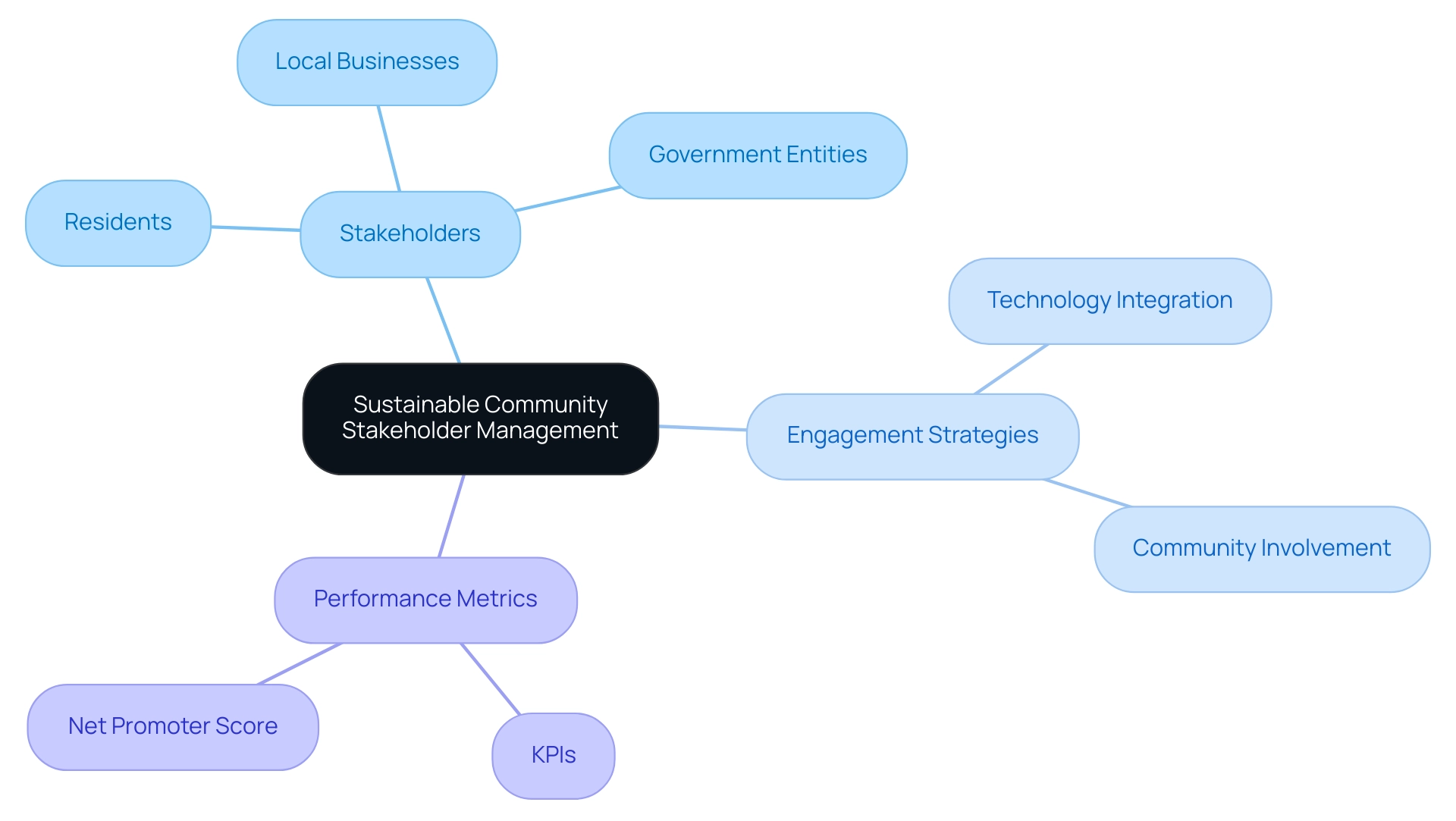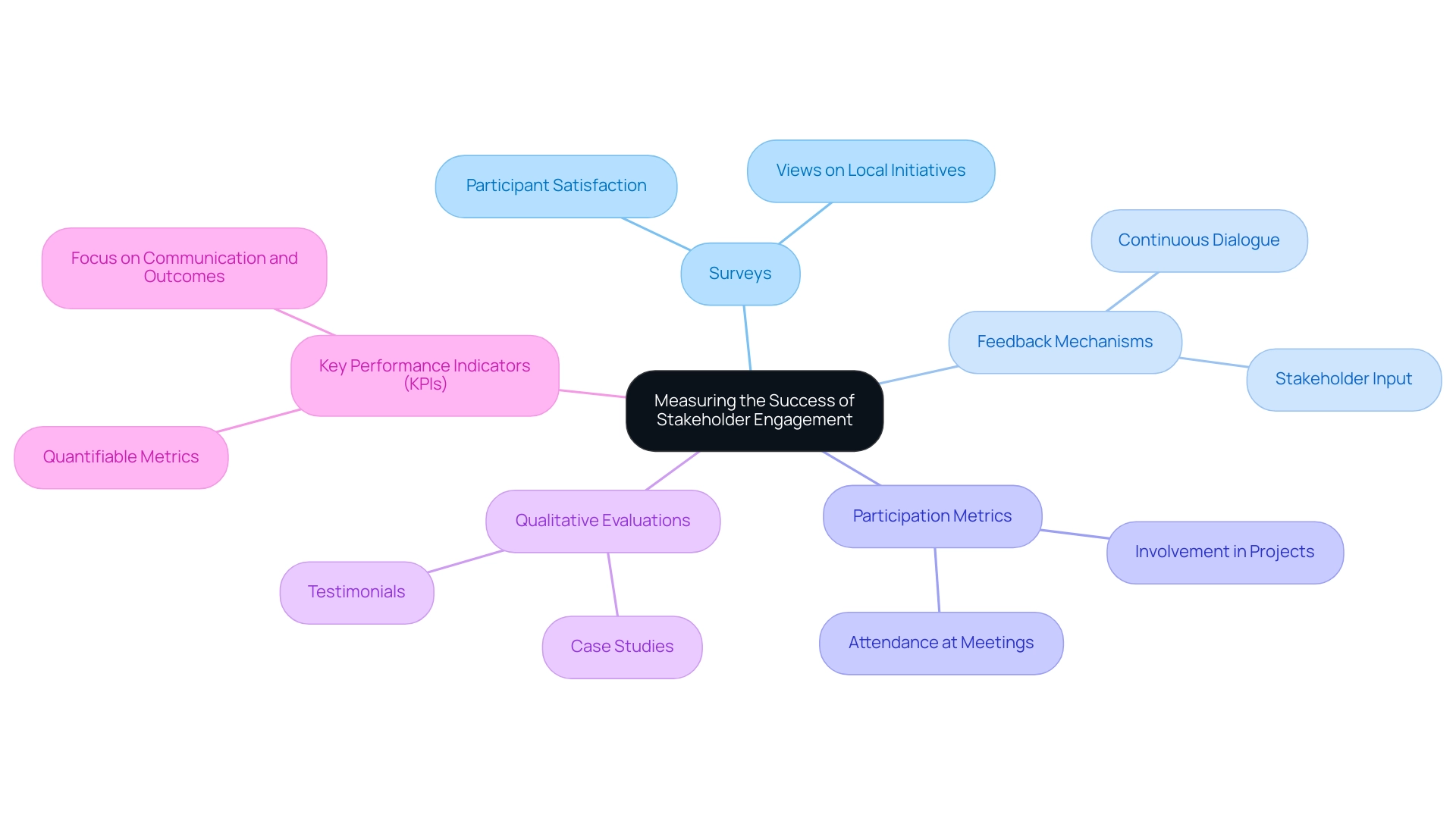Introduction
In the quest for sustainable community development, effective stakeholder management emerges as a cornerstone for success. Organizations are increasingly recognizing the importance of engaging with diverse stakeholders—residents, businesses, government entities, and non-profits—to foster collaboration and resilience. As they navigate the complexities of community initiatives, the integration of technology and innovative engagement strategies becomes paramount.
However, the path is not without challenges; issues such as stakeholder apathy and conflicting interests can hinder progress. By adopting best practices that prioritize transparency, inclusivity, and responsiveness, organizations can create meaningful connections that drive impactful outcomes.
This article delves into the principles, challenges, and strategies essential for mastering sustainable community stakeholder management, equipping leaders with the insights needed to cultivate thriving, engaged communities.
Defining Sustainable Community Stakeholder Management
Sustainable community stakeholder management serves as a strategic method to interact with individuals, groups, and entities involved in or affected by local initiatives. This approach highlights the significance of nurturing long-term connections and encouraging cooperation among a varied group of participants, including residents, local businesses, and government entities. By prioritizing sustainable community stakeholder management in these interactions, entities can effectively address immediate community challenges while also fostering resilience and adaptability for future changes.
Recent developments, such as Maptionnaire's new community participation platform, introduce innovative modules designed to enhance citizen involvement and performance analysis, showcasing the latest trends in community participation strategies for 2024. A crucial element of efficient management of interested parties is the creation of clear Key Performance Indicators (KPIs) for involvement. The case study on Key Performance Indicators for Stakeholder Engagement illustrates how organizations can track progress and make informed decisions using metrics like engagement rates and the Net Promoter Score.
For instance, one software company achieved an impressive +70 in Net Promoter Score, underscoring its significance as a vital tool for assessing stakeholder relationships and their influence on overall success.
In the words of Maptionnaire, > Re-thinking the Idea of Representative Democracy – Technology is Not the Silver Bullet. This statement emphasizes the necessity of balancing technological solutions with authentic public involvement. By integrating technology thoughtfully, organizations can craft inclusive policies and practices that promote social, economic, and environmental well-being.
Therefore, efficient participant management is crucial for promoting sustainable community stakeholder management that addresses present requirements and ensures a resilient future.

Key Principles of Effective Stakeholder Engagement in Communities
The successful involvement of interested parties in localities is dependent on three core principles of sustainable community stakeholder management:
-
Transparency
- Transparency entails sharing information regarding local initiatives and decision-making openly, which fosters trust and promotes increased participant involvement.
-
Inclusivity
- Inclusivity ensures that diverse voices, particularly those from marginalized groups, are actively heard and considered, fostering a sense of belonging and ownership among members, thus enhancing overall project support.
-
Responsiveness
- Responsiveness reflects the ability to swiftly address concerns from involved parties, signaling that their input is valued and taken seriously.
A notable case study illustrating these principles is the NC Promise Tuition Plan, which has significantly reduced tuition costs to $500 per semester at four UNC system institutions:
- Elizabeth City State University
- Fayetteville State University
- The University of North Carolina at Pembroke
- Western Carolina University
This initiative illustrates how transparency in sharing information about tuition affordability, inclusivity by considering the needs of diverse individuals, and responsiveness to concerns about higher education costs can mobilize resources and align interests toward shared objectives, paving the way for more successful outcomes in sustainable community stakeholder management.
Challenges in Sustainable Community Stakeholder Management
Sustainable community stakeholder management is fraught with challenges that can significantly undermine the effectiveness of initiatives. Stakeholder apathy is a prominent issue, often resulting from community members feeling disconnected from projects or undervaluing their contributions. Research from the Tampere Tunnel's official Facebook account indicates that posts regarding governance and management issues can reduce participation by 31.1%, highlighting the critical nature of effective communication in fostering involvement.
Conflicting interests among parties further complicate this landscape, as diverse priorities can create barriers to consensus-building. Additionally, resource limitations—whether financial, human, or temporal—can severely restrict the capacity for meaningful engagement. To counter these challenges, local leaders must adopt targeted outreach strategies that resonate with stakeholders involved in sustainable community stakeholder management.
- Facilitating open forums for dialogue encourages participation and allows for the expression of varying viewpoints.
- Leveraging technology, such as social media platforms, can significantly broaden outreach efforts, helping to engage a larger audience and cultivate a stronger sense of community involvement.
A notable case study in this realm is the collaboration with youth organizations to promote health among young people, which successfully empowered participants and led to improved health outcomes through focused initiatives.
As outlined in Yin's (2015) guide on case study research design, these strategies are essential for understanding and addressing participant dynamics. By applying these methods, leaders can effectively address participant indifference and conflicting interests, which is essential for achieving sustainable community stakeholder management.
Measuring the Success of Stakeholder Engagement
Accurate assessment of participant involvement success is essential for organizations that are implementing sustainable community stakeholder management to improve their relationships with the public. A multifaceted approach is essential for sustainable community stakeholder management, incorporating surveys, feedback mechanisms, and participation metrics. Surveys act as a beneficial instrument to assess participant satisfaction and views concerning local initiatives, offering measurable data that can guide strategic choices.
Feedback mechanisms promote a continuous dialogue within sustainable community stakeholder management, enabling stakeholders to express their views and assist in the improvement of initiatives, thereby boosting overall involvement.
Participation metrics, such as attendance at community meetings and involvement in various projects, are essential indicators of involvement levels and stakeholder interest in sustainable community stakeholder management. These metrics not only reflect current participation but also highlight areas for potential improvement. Qualitative evaluations, including case studies and testimonials, provide deeper insights into the effectiveness of sustainable community stakeholder management efforts, revealing the real-world impact of initiatives.
As Stephen Townsend, a graduate teaching associate at Columbia University, asserts,
Focusing on outcomes rather than deliverables can create space for exploring multiple alternatives.
This viewpoint motivates organizations to prioritize measurable results in sustainable community stakeholder management when establishing their key performance indicators (KPIs) for participant interaction, which should be quantifiable, specific to the organization, and concentrated on communication and outcomes. The recent focus on establishing KPIs underscores the significance of measuring results over time, ensuring continuous improvement in interactions with involved parties and enhancing sustainable community stakeholder management.
Furthermore, the case study titled 'Managing Your Networks with FiscalNote' highlights the necessity of building and maintaining productive relationships with these individuals, emphasizing the importance of sustainable community stakeholder management for effective meetings. Using suitable tools guarantees that participant meetings are fruitful, ultimately aiding in the sustainable community stakeholder management and improved involvement. Notably, statistics indicate that almost half of government relations professionals spend between 6 and 10 hours a week engaging with interested parties, underscoring the significant investment in engagement efforts.
By systematically evaluating these factors—combining quantitative data with qualitative insights—organizations can refine their strategies and significantly enhance their effectiveness in sustainable community stakeholder management.

Best Practices for Sustainable Community Stakeholder Management
Effective sustainable community stakeholder management relies on several best practices, including:
- Establishing clear communication channels
- Fostering strategic partnerships
- Prioritizing long-term relationships
Clear communication is essential; timely and relevant information not only builds trust but also enables participants to engage meaningfully. As Lis Anderson, founder of PR consultancy AMBITIOUS, asserts, Navigating [[[[[[[your communication goals](https://forbes.com/councils](https://forbes.com/councils](https://forbes.com/councils](https://forbes.com/councils](https://forbes.com/councils/forbesagencycouncil/2023/10/27/how-to-create-an-effective-stakeholder-communication-plan)](https://forbes.com/councils/forbesagencycouncil/2023/10/27/how-to-create-an-effective-stakeholder-communication-plan)/forbesagencycouncil/2023/10/27/how-to-create-an-effective-stakeholder-communication-plan)/forbesagencycouncil/2023/10/27/how-to-create-an-effective-stakeholder-communication-plan)/forbesagencycouncil/2023/10/27/how-to-create-an-effective-stakeholder-communication-plan)/forbesagencycouncil/2023/10/27/how-to-create-an-effective-stakeholder-communication-plan)](https://forbes.com/councils/forbesagencycouncil/2023/10/27/how-to-create-an-effective-stakeholder-communication-plan) and defining their objectives with clarity is not just a nice to have; it's business critical.
Moreover, continuous assessment of communication efficiency is vital for implementing required modifications to management strategies, ensuring that the communication stays pertinent and influential.
Collaborations with local entities, businesses, and government bodies further enhance resource sharing and joint efforts, improving initiatives in the area. For instance, local organizations that actively engage residents through workshops and feedback sessions often witness increased participation and support for their initiatives. The significance of efficient participant management is emphasized by the fact that Social and Environmental Performance is a vital focus area, referred to 37 times in relevant discussions, showcasing its relevance in public engagement.
However, it's essential to acknowledge the constraints of particular communication methods. Text messaging through platforms like SMS, Messenger, or WhatsApp can efficiently deliver short messages to multiple recipients, confirming receipt of messages. Yet, these messages can also be easily overlooked, leading to a potential loss of critical information.
By implementing these best practices—clear communication, partnership cultivation, ongoing evaluation, and a focus on long-term relationships—organizations can foster a more inclusive and effective sustainable community stakeholder management strategy that propels community development.
Conclusion
Sustainable community stakeholder management is vital for fostering collaboration and resilience among diverse groups invested in community initiatives. By integrating transparency, inclusivity, and responsiveness into engagement practices, organizations can build trust and encourage participation from all stakeholders, ensuring that their voices are heard and valued. The principles outlined in successful initiatives, such as the NC Promise Tuition Plan, illustrate how effective communication and a focus on community needs can mobilize resources and align interests towards shared goals.
Despite the challenges posed by stakeholder apathy and conflicting interests, adopting targeted outreach strategies and leveraging technology can significantly enhance engagement efforts. By facilitating open dialogue and utilizing social media for broader outreach, organizations can overcome barriers and cultivate a sense of community involvement. The emphasis on measuring success through surveys, feedback mechanisms, and participation metrics further reinforces the need for continuous improvement in stakeholder relationships.
Implementing best practices such as establishing clear communication channels and fostering strategic partnerships will drive sustainable community development. By prioritizing long-term relationships and evaluating communication effectiveness, organizations can create a more inclusive stakeholder management strategy that not only addresses current needs but also prepares communities for future challenges. The time to take action is now; by mastering these principles and strategies, leaders can cultivate thriving, engaged communities that contribute to a sustainable future.
Frequently Asked Questions
What is sustainable community stakeholder management?
Sustainable community stakeholder management is a strategic method to engage with individuals, groups, and entities involved in or affected by local initiatives, focusing on building long-term connections and cooperation among participants such as residents, local businesses, and government entities.
What are the key principles of sustainable community stakeholder management?
The three core principles are: 1. Transparency - Sharing information openly to foster trust and encourage participation. 2. Inclusivity - Ensuring diverse voices, especially from marginalized groups, are heard, promoting a sense of belonging. 3. Responsiveness - Addressing concerns from stakeholders promptly to show that their input is valued.
How can organizations assess the success of stakeholder involvement?
Organizations can assess success through a multifaceted approach that includes surveys, feedback mechanisms, participation metrics, and qualitative evaluations such as case studies and testimonials, which provide measurable data and insights into stakeholder engagement.
What role do Key Performance Indicators (KPIs) play in stakeholder management?
KPIs are essential for tracking progress and making informed decisions regarding stakeholder engagement, focusing on measurable outcomes that enhance interactions with involved parties.
What challenges do sustainable community stakeholder management initiatives face?
Challenges include stakeholder apathy, conflicting interests among parties, and resource limitations, which can hinder meaningful engagement and consensus-building.
How can organizations overcome challenges in stakeholder engagement?
Organizations can overcome challenges by facilitating open forums for dialogue, leveraging technology for broader outreach, and employing targeted outreach strategies that resonate with stakeholders.
What best practices should organizations follow for effective stakeholder management?
Best practices include establishing clear communication channels, fostering strategic partnerships, prioritizing long-term relationships, and continuously assessing communication effectiveness to ensure relevance and impact.
How does technology influence community participation in stakeholder management?
Technology can enhance citizen involvement and performance analysis, allowing organizations to craft inclusive policies and practices that promote social, economic, and environmental well-being when integrated thoughtfully.




